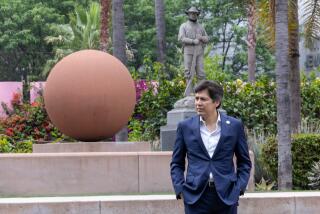History in Your Face
Don’t let the name fool you. The Museum in Black covers a colorful spectrum of the African American experience.
This storefront museum, at 4331 Degnan Blvd. in Los Angeles’ Leimert Park district, is packed to bursting with books, signs, figurines and other memorabilia dating from slavery through segregation to today. The collection covers historical figures real and invented, from Frederick Douglass to Aunt Jemima, Uncle Ben to the Rev. Martin Luther King Jr., Jazzbo to FloJo and O.J. Simpson.
Parts of the collection can be tough to take. A chest of rusted half-disks that clamp together may make you think of cattle ranching--until the sickening realization hits that these were shackles used to transport slaves from Africa. In the same chest are stone rings the size of small doughnuts. Hung on slaves’ bodies in clusters of 50 to 100 pounds, they would impede escapes. On some of the rings stains of blood are still visible.
There are “whites only” and “colored” signs from restrooms and waiting rooms. There are figurines and product packaging featuring African Americans with stereotypical grins, and an entire display devoted to the female archetype “Mammy.” Although these items may seem shockingly racist these days, many were common as recently as the 1960s.
The museum’s owner, Brian Breye, says the slavery and segregation collection “represents a sad chapter in American history. But it needs to be seen. It needs to be shown.”
But Breye is equally devoted to promoting the contributions of African Americans. Features about and books by African American leaders and celebrities fill a bookcase that covers a long wall.
Around the museum, cards are posted listing inventions by African Americans: the traffic signal and the dustpan, the refrigerated railroad car and the pencil sharpener.
Thomas L. Jennings was the first African American to receive a patent, in 1821, for a dry-cleaning process. He used the proceeds to buy his family out of slavery. And the phrase “the real McCoy” refers to a technology for self-lubrication of machinery, patented by Elijah J. McCoy in 1872. His loyal customers insisted on the genuine article.
*
Most of the African American history collection is in the museum’s back room. In the larger front gallery is an impressive collection of art and artifacts from Africa, much of it religious in nature.
“Before you consider it African art,” Breye says, “it has to be considered spiritual art.”
Some 425 items range from ceremonial masks and sculptures to furniture, weapons and farm implements. Included is a 12-foot wooden frame, brightly painted with antelopes, to be hoisted overhead during the fertility/harvest festival of the Bozo (pronounced BU-zu) tribe of Mali. The frame’s headpiece is shaped like an antelope’s head and has metallic eyes: It is said that whenever someone blesses or curses another, the eyes will reflect the wish back on the person who made it.
There’s also a cloth shrine called an egungun, worn as a costume by babalou (priests) of the Yoruba tribe of Nigeria. From the top of the egungun dangle hundreds of strips of fabric, donated by tribespeople as tokens of appreciation and commendation.
Breye, born in Brooklyn “way more than 50” years ago, has spent more than 30 years amassing and exhibiting this collection; the Museum in Black has been at this Leimert Park location for 11 of them. Most of the visitors are groups from schools and community organizations.
But there also have been individual tourists from as far away as Europe. Recently state Sen. Tom Hayden (D-Santa Monica) came by with two visitors from Belfast, Northern Ireland, who had just been to the Museum of Tolerance in West Los Angeles and wanted to see a community museum.
Running the Museum in Black is no easy job. It requires frequent buying trips to the American South (where, Breye says, he was “cussed at, spit at, locked up” in the late ‘50s and early ‘60s) and working an extensive network in the African art world. It is not always profitable, either. Some of the African art is for sale or rental (movie studios are big clients), but nothing else is, and the museum survives largely on donations. So, Breye says, “one week I have steak and potatoes, another week nothing but potatoes.”
He says it’s all worth it, though, every time he sees a “poor little black kid who leaves with a sense of pride.”
More to Read
Sign up for The Wild
We’ll help you find the best places to hike, bike and run, as well as the perfect silent spots for meditation and yoga.
You may occasionally receive promotional content from the Los Angeles Times.






